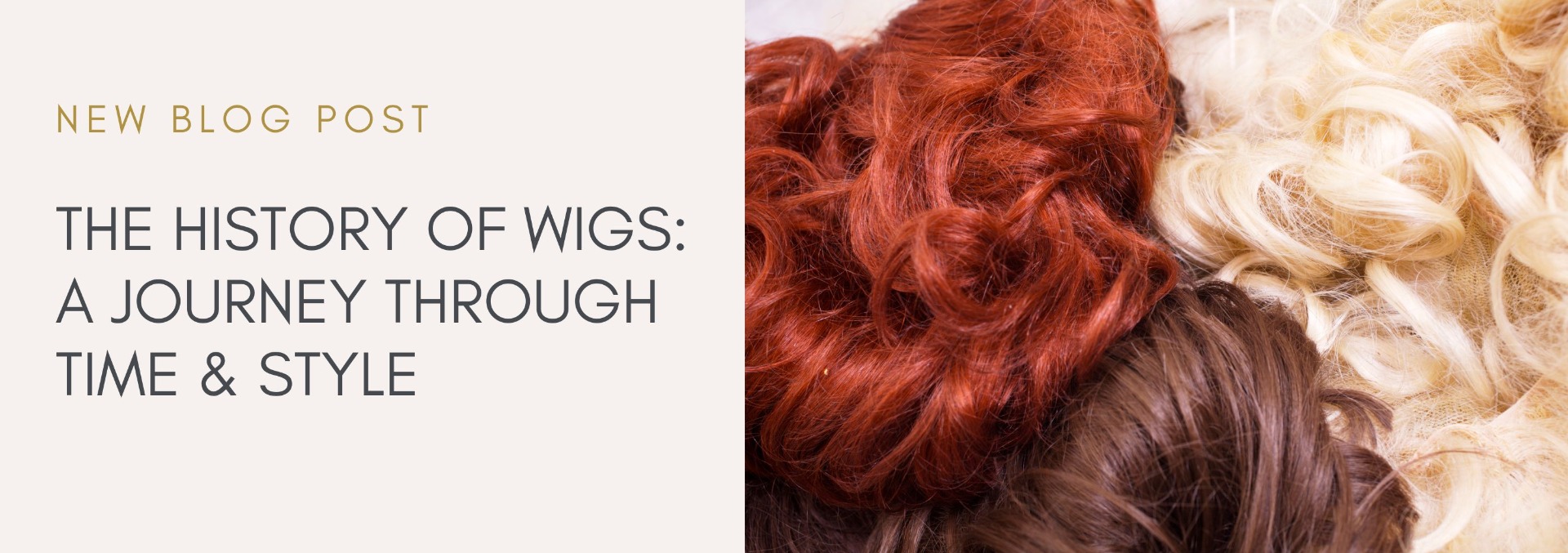
Welcome, wig enthusiasts, to a captivating exploration of one of fashion's most enduring accessories: the wig! In this blog we will unravel the fascinating history of wigs, from their ancient origins to their glamorous heyday in European courts.
Let's start with a little etymology. Did you know that the term "wig" finds its roots in the French word “(per)ruque”? Initially crafted from a variety of materials including horsehair, human hair, wool, feathers, buffalo hair, or even synthetics, wigs were more than just a fashion statement—they were practical solutions to a myriad of hair-related challenges.
Fast forward to 1675, and the English language welcomes the term "wig" with open arms, shortening it from "periwig." This marked the beginning of an era where wigs weren't just worn—they were celebrated, especially in England, which became a global hub for exquisite wig craftsmanship. Shakespeare himself couldn't resist mentioning the trade in his works, solidifying wigs' place in history.
But wigs weren't exclusive to English society, they have been around for centuries! From ancient Egypt, where they shielded shaved heads from the blazing sun, to ancient Rome, where they were fashioned from the hair of captured Barbarian Slaves, wigs have had quite the journey through time.
After a thousand-year hiatus in the West, wigs made a triumphant comeback in the 16th century. They served a purpose beyond mere style! In an age of questionable hygiene, wigs were a godsend, helping to stave off pesky head lice by replacing natural hair with a more manageable alternative.
Now, let's talk about extravagance. When it comes to wigs, nobody did it quite like the French courts of Louis XIV and Marie Antoinette. Picture this: gigantic wigs so elaborate that wearers couldn't even sit down comfortably. Constructed over intricate frames and adorned with horse or goat hair, these wigs were a sight to behold, held in place by a concoction of flour, gum, starch, or even plaster of Paris.
Powdered Wigs:
But it wasn't until Charles II's restoration to the English throne in 1660 that wigs truly became the height of fashion. Inspired by his time in France, Charles popularized "perukes" or "periwigs" among men, sparking a trend that swept through English society. These powdered wigs, often flowing down to the shoulders or beyond, became the epitome of nobility and refinement, coveted by the upper echelons of society.
In the intricate tapestry of history, fashion often intertwines with necessity, creating trends that endure and evolve over the ages. Among the most fascinating relics of bygone eras are the powdered wigs of medieval England, these ostentatious headpieces, though once the epitome of elegance, had a secret discomfort beneath their ornate façades.
During the tumultuous 15th century, Europe was besieged by the devastating scourge of the plague, a relentless epidemic that ravaged communities and left a trail of suffering in its wake. Amidst the chaos of widespread illness and societal upheaval, the demand for powdered wigs surged. With afflictions ranging from open sores to patchy hair loss plaguing the populace, many turned to these elaborate wigs as a solution, seeking to conceal the physical toll exacted by disease and infirmity.
In 1665, London diarist Samuel Pepys recorded the day his barber shaved his head and he tried his Periwig for the first time, but in a year of the plague he was uneasy about wearing it:
“3rd September 1665: Up, and put on my colored silk suit, very fine, and my new periwig, bought a good while since, but darst not wear it because the plague was in Westminster when I bought it. And it is a wonder what will be the fashion after the plague is done as to periwigs, for nobody will dare to buy any hair for fear of the infection? That it had been cut off the heads of people dead of the plague.”
The emergence of the Wigmakers Guild in France in 1665 marked a pivotal moment in the history of wig craftsmanship, igniting a trend that soon swept across the continent. These master artisans, revered for their skill and artistry, crafted elaborate wigs of unparalleled grandeur, adorning the heads of nobility and commoners alike with cascading curls and intricate designs.
By the dawn of the 18th century, men's wigs had transformed, their once opulent curls now rendered a pristine white through the application of powdered starch. Fragrant with the scent of orange flower or lavender, these powdered wigs became synonymous with refinement and sophistication, a symbol of status and prestige in a society enamoured with extravagance.
However, amidst the powder-scented airs of aristocratic salons, a different trend emerged among women. Contrary to popular belief, the ladies of the 18th century did not wear wigs, but wore a coiffure the we now call hair extensions.
End of the English wig period:
Towards the end of the 18th century, the Englishmen resorted to keeping their hair short and neatly cut and the use of wigs became much lesser. This could also be due to the reign of a female, Queen Victoria that did not appear to wear any wigs. Even her husband, who was the icon during the century, Prince Albert Consort never wore wigs. Hence, short hair was the new fashion adopted by the 19th century onwards.
In the years that followed, the wearing of wigs as a symbol of social status fell out of favour. In the aftermath of World War I, women sold their hair to help with family finances.
Wigs today:
In Britain and most commonwealth nations, special wigs are worn by barristers, judges and certain parliamentary and civic officials as a symbol of office, this is a tradition dating back to the 17th century. The original purpose of the legal wig was to provide a form of anonymity and safety.
Today, wigs are more popular than ever, with a wide range of styles and materials available. Many people wear wigs to change their hairstyle without committing to something permanent. Wigs are also worn for medical, religious or cultural reasons, as in the LGBTQ+ community. They are also used for theatrical performances and cosplay.
Wigs have come a long way since their early origins in ancient times. From their use as a symbol of social status to their current popularity among people from all walks of life, wigs have played a significant role in fashion and culture throughout history. With advancements in technology and wig-making techniques the use of new fibers such as Cyber and V Hair developed by Aderans is the closest manmade fiber to human hair. The possibilities for wig styles and materials are endless, ensuring that wigs will continue to be a staple accessory for generations to come.





